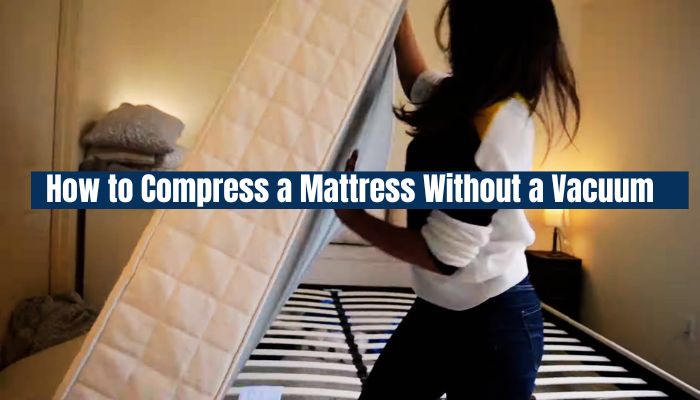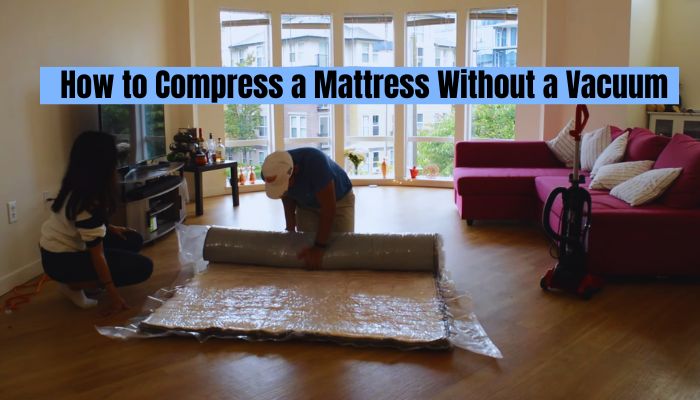Are you looking to compress a mattress without a vacuum? Explore our step-by-step guide to learn alternative methods of mattress compression. Easy, quick, and cost-effective!
Mattresses are bulky and can be challenging to move, especially when relocating or storing them for an extended period. Compression is a method that helps reduce the Mattress’s size, making it easier to handle. This article will discuss the importance of compressing a mattress, the tools needed, a step-by-step guide on compressing a bed without a vacuum, and alternative methods if you don’t have the required tools.
Why Compress a Mattress?
Compressing a mattress has several benefits:
- Space Saving: Compressing a mattress reduces its volume, making it easier to store in tight spaces or move through narrow hallways and staircases.
- Ease of Transportation: A compressed mattress is easier to transport in a vehicle, as it takes up less space and can be handled by a single person.
- Prolonging Mattress Life: Storing a mattress properly by compressing and wrapping it in plastic can protect it from dust, dirt, and pests, extending its lifespan.
Tools Needed for Mattress Compression
To compress a mattress without a vacuum, you will need the following tools:
- Plastic Mattress Bag: This will keep the Mattress clean and protected during compression.
- Duct Tape: To seal the plastic bag and keep the air out.
- Heavy-Duty Straps: To compress the Mattress and keep it compressed during transportation or storage.
Step-by-Step Guide to Compress a Mattress
Follow these steps to compress a mattress without using a vacuum:
- Preparation: Remove all bedding, pillows, and mattress protectors from the Mattress. Clean the Mattress thoroughly to remove any dirt or debris.
- Placing the Mattress in the Bag: Carefully slide the Mattress into the plastic mattress bag. Make sure the Mattress is centered in the bag and that the bag is completely closed.
- Removing Air: Start at one end of the Mattress and roll it tightly towards the other, pushing out as much air as possible. You can also have someone help you by pressing down on the Mattress as you roll it.
- Securing the Mattress: Once the Mattress is rolled up and the air is removed, use the heavy-duty straps to secure it. Please make sure the straps are tight enough to keep the Mattress compressed but not so tight that it damages the Mattress.
- Sealing the Bag: Use duct tape to seal the open end of the plastic bag. Ensure the video is securely attached to the bag and there are no openings where air can enter.
Alternative Methods of Mattress Compression
If you don’t have the tools listed above, there are alternative methods you can use to compress a mattress:
- Using a DIY Vacuum Bag: If you have a large plastic bag and a vacuum cleaner, you can create a DIY vacuum bag. Place the Mattress inside the plastic bag, seal the load as much as possible, and use the vacuum cleaner to suck out the air. Make sure to fill the bag completely after removing the air.
- Manual Compression: If you don’t have a plastic mattress bag or a vacuum cleaner, you can still compress the Mattress manually. Fold the Mattress in half and have someone help you hold it in place while you wrap it with heavy-duty straps. This method may not be as effective as the others. However, it can still help reduce the size of the Mattress for more accessible transportation or storage.
Tips for Successful Mattress Compression
Selecting the Right Bag
The first step in mattress compression is selecting the right bag. You will need a mattress compression bag, a heavy-duty plastic bag designed to withstand the pressure of the compressed Mattress. Make sure to choose a bag that is the right size for your Mattress. If the bag is too small, you cannot fit the Mattress inside. If it is too large, there will be too much excess plastic, making it difficult to remove all the air.
Removing Air Properly
Once you have the Mattress inside the bag, it is time to remove the air. Use a vacuum cleaner with a hose attachment to suck out all the air from the Mattress. Make sure to go over the entire surface of the Mattress to ensure that all the air is removed. It is important to remove as much air as possible to reduce the size of the Mattress as much as possible.
Securing the Mattress
After removing all the air, it is essential to secure the Mattress properly. Seal the bag using the adhesive strip provided. Ensure the bag is sealed tightly to prevent any air from entering. Additionally, you can also use packing tape to reinforce the seal.
Common Mistakes to Avoid During Mattress Compression
Not Cleaning the Mattress
One common mistake is not cleaning the Mattress before compressing it. It is essential to clean the Mattress thoroughly to remove any dust, dirt, and debris. This will help maintain the quality of the Mattress and prevent any odors from developing. At the same time, the Mattress is compressed and stored.
Using the Wrong Bag Size
Another common mistake is using the wrong size bag. As mentioned earlier, choosing a pack that is the right size for your Mattress is essential. Using a bag that is too small or too large can cause problems during the compression process.
Not Removing All Air
It is essential to remove as much air as possible from the Mattress to reduce its size as much as possible. Some people do not remove all the air, which can result in the Mattress not being appropriately compressed.

How to Store a Compressed Mattress
Choosing the Right Location
Choosing the right location for storing your compressed Mattress is crucial. The area should be dry and moisture-free to prevent mold and mildew from developing. Additionally, it should also be free from pests and rodents.
Keep Away from Sharp Objects
Make sure to keep the compressed Mattress away from any sharp objects that could puncture the plastic bag and cause the Mattress to expand.
Regular Checks
It is essential to check the Mattress regularly to ensure it is still in good condition. Check for any signs of mold, mildew, or pests, and address any issues immediately.
Read more about How to Clean Pillow Top Mattress. Learn Tips & Tricks
Benefits of Mattress Compression
Space Saving
One of the main benefits of mattress compression is that it saves a lot of space. A compressed mattress takes up significantly less space than a regular mattress, making it easier to transport and store.
Ease of Transport
A compressed mattress is much easier to handle and transport. It is lighter and more compact, making moving around and fitting into vehicles easier.
Longevity of Mattress
Compressing the Mattress helps maintain its quality by protecting it from dust, dirt, and moisture. This helps in extending the lifespan of the Mattress.
FAQ on Mattress Compression
Is it safe to compress a mattress?
Yes, it is safe to compress a mattress. However, it is essential to follow the proper steps and precautions to ensure the safety of the Mattress.
How long can I keep a mattress compressed?
Owning a bed crammed for no longer than six months is recommended. However, checking the manufacturer’s instructions for specific guidelines is always best.
Will compress the mattress damage it?
Squeezing the Mattress will not damage it if done properly. It is essential to clean the Mattress, use the right size bag, remove all the air, and store it in a dry and pest-free location.
Can I compress any Mattress?
Most types of mattresses can be shortened. However, checking the manufacturer’s instructions is always best to see if your specific Mattress is suitable for compression.
Do I need any special equipment to compress a mattress?
You will need a mattress compression bag and a vacuum cleaner with a hose attachment. These are the only tools required to compress a mattress.

Conclusion
Mattress compression is a valuable technique for making the Mattress easier to handle, transport, and store. It is essential to follow the proper steps and precautions to ensure the success of the mattress compression process. By selecting the right bag, removing all the air, securing the Mattress properly, and storing it in the right location, you can maintain the quality of your Mattress and extend its lifespan.
Remember to clean the Mattress before compressing it, use the right size bag, remove all the air, and store it in a dry and pest-free location. Following these tips and avoiding common mistakes, you can compress and keep your Mattress.
